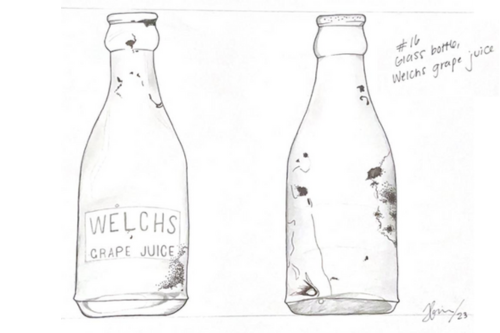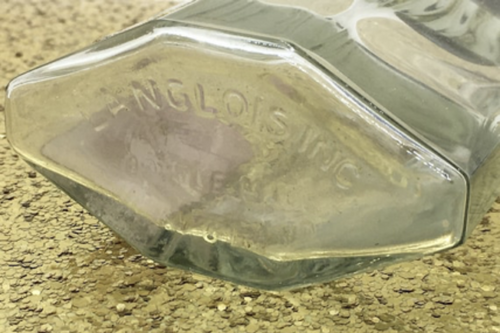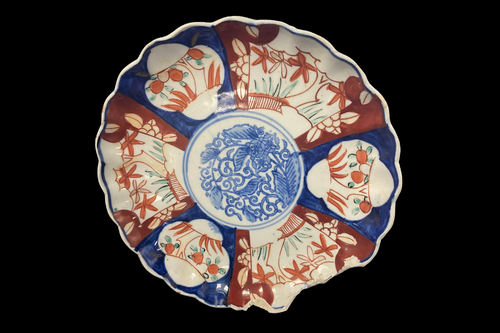
Ceramic Consumer Choices
Collections Curiosities is a monthly blog highlighting intriguing artifacts, books, and archival materials that staff, volunteers, and interns have discovered in Center collections and the Center Library. This month, SDAC Volunteer Linda Coulson explores whether a particular historic ceramic tableware archaeological assemblage can be correlated to the socioeconomic status of the assemblage’s owners.
Ceramic Consumer Choices and What They May Say About Early 20th-Century San Diego
By SDAC Volunteer Linda Coulson
In trying to examine my rather broad research question of whether a particular historic ceramic tableware archaeological assemblage can be correlated to the socioeconomic status of the assemblage’s owners, I found perhaps a more descriptive way of looking at the question. One method of historical archaeology has been to develop scaling methods which place relative monetary values on particular material types of ceramic artifacts, and from that conclude that only members of certain socioeconomic classes would have been likely to purchase, utilize, and dispose of these artifacts. This method does provide a quantitative means of analyzing the relative economic costs of ceramic assemblages and thus a tool for examining socioeconomic status. When we consider socioeconomic status, we are considering an abstract concept where social status and economic status are assumed to be equivalent, with no real sound basis for this assumption. Assessing the original monetary value of an assemblage and then jumping from that to the presumed economic resources of the owners and their social standing does not tell us very much about the original owners of the assemblage. It really does not tell us the “why” in the owner’s choice to consume these particular types of artifacts. Were consumer choices only based on financial resources or availability or possible inheritance, or did they reflect, to some degree, personal agency? Is it possible that individuals were choosing particular ceramic items based on the meanings they attached to those items? Could individuals and families have been trying to express their sense of self-identity and group identity through the ceramic consumption choices they made?
The Liffreing Family Farmstead
Archaeological Excavation Site: El Cajon, San Diego County
The Liffreing House Dump consistent with a historic farmhouse refuse pit
Time Span: 1890-1930
Excavated by: Walter Enterprises in 2001
Curation: San Diego Archaeological Center, Collection Number SDAC 122
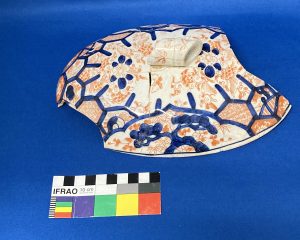
The first historic archaeological ceramic assemblage to be analyzed for this report is from the Liffreing Farmstead. The Liffreings, a family of upper-middle-class citrus growers, included a seventy-year-old widow and her six adult children, who purchased sixty acres of land near El Cajon, CA in 1892 in order to establish a citrus farm. The fact that Mrs. Liffreing had the financial resources to purchase this much land in 1892 attests to her degree of wealth prior to building the farm. This family then worked their rural farmstead from the early 1890s through the early 1930s and came to represent the elite of their rural community. What is particularly interesting here is that the Liffreing assemblage, independent of the household’s high economic status, still reflected many of the basic traits common to rural farmstead households of the time. Their ceramic consumption pattern represented basic differences between rural and urban ceramic purchases, independent of their greater wealth.
For the Liffreing household, their ceramic consumption appears to have prioritized the values, lifestyle, and attitudes of the rural farmstead community in San Diego between 1870 and 1930, of which they were a prominent part. Tables set with attractive dinnerware to reflect economic success may have been valued in urban households, but farm values emphasized conservation and recycling with extravagant purchases discouraged. The Liffreing assemblage contained primarily moderate-priced, American-made, ironstone tableware. Ironstone was a sturdy, vitreous, bright white type of earthenware. It was much less expensive than porcelain, hence the moniker “poor man’s porcelain.” The Liffreings’ ironstone was plain white or had a simple embossed white-on-white rim design. They do appear to have had more than one matching dinner set suggesting that this was something the Liffreing household valued and were willing to invest in, unlike many other households. This, along with the greater quantity rather than quality of ceramic tableware pieces, would seem to be a way the Liffreing household expressed their larger available financial budget.
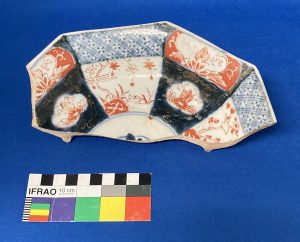
The assemblage does contain a small number of teacups and saucers, and it is interesting that nearly equal number of porcelain versus undecorated cups and saucers were porcelain. This suggests that the Liffreings placed some importance on traditional afternoon tea gatherings and used the quality of their tea service to display their elite position within the community.
There is one piece contained in the Liffreing assemblage that stands out as unique among the other ceramic artifacts. This is a large, colorful, hand-painted, Imari-style porcelain oval-shaped lid to a missing serving bowl. Since this piece is so different from the rest of the assemblage and is rather audacious in comparison, did the Liffreing Family purchase it? How else might the family have acquired it? There is the possibility that it was a gift or a family heirloom passed down from a previous generation and only brought out on special occasions.
The Liffreing assemblage appears to represent a historic household for which social and cultural group membership played a much bigger role than economic class in determining ceramic tableware consumer choices. In this case, it appears the symbolism of their membership in their rural community was of greater importance to them than a conspicuous display of their comparative wealth. Granted, the Liffreing assemblage may represent an idiosyncratic household, but perhaps it is one of many similar households.
The Rice Family Homesite
Archaeological Excavation Site: City of San Diego
Rice Homesite including the remains of a two-story residence and outbuilding
Time Span: 1925-1932
Excavated by: Heritage Resources in 2000
Curation: San Diego Archaeological Center, Collection Number SDAC 47
Another of the historic assemblages, the John B. Rice suburban homesite, makes for an interesting contrast with the Liffreing farmstead. The Rice family homesite was located in southeastern San Diego between 1925 and 1932. This property was situated in the midst of agricultural activity, but also at the eastern extent of urban development spreading east from the City of San Diego. Thus, there would have been both urban and rural influences on the lifestyle of the Rice family. Mr. Rice had started as a laborer with the City of San Diego Operating Department and shortly thereafter was promoted to foreman, so the family enjoyed a certain amount of economic success. Based upon the assemblage’s ceramic tableware pieces, particularly the tea service items, the Rice family appears to have placed a good deal of importance on displaying an attractive table setting. This involved several gold-rimmed and porcelain pieces with some similar decorative elements. In fact, much of the ceramic assemblage appears to have an Asian motif, perhaps in an attempt to create a coordinating table service.
The Rice family seems to have made a consumption choice to invest in more expensive ceramic tableware. We can possibly deduce from this that they attached particular symbolism to attractive tableware. The Rice household may have felt that such a table display would convey a message of upwardly mobile middle-class status. Also, the Rice assemblage contains a high percentage of bottles and other product containers, comparable to middle- and upper-middle-class urban household assemblages.
The Rice assemblage can also be analyzed in yet another way. There is an older economic scaling system developed by George L. Miller (Classification and Economic Scaling of 19th-Century Ceramics 1980, pp. 1-40 and A Revised Set of CC Index Values for Classification and Economic Scaling of English Ceramics from 1787 to 1880, 1991, pp. 1-25) which assigns relative index values (monetary cost) to a site’s ceramic assemblage, based primarily on decorative types. It was felt that the attribute of decoration affected historic ceramic purchasing prices more so than other attributes. Based on the Miller economic system, urban ceramic assemblage values tend to be considerably higher than rural values. The Rice assemblage, when measured, obtained a ceramic index value significantly higher than most other rural sites and even higher than many other middle- to upper-middle status urban sites. This again suggests that the Rice household attached a lot of meaning to having very attractive ceramic tableware.
Combining all of this information with the fact that the Rice family lived comfortably in a two-story residence with an outbuilding certainly points to them pursuing the period’s commonly held dream to achieve middle class status and to be perceived that way. If all this holds true, than the Rice family’s particular investment in ceramic tableware held special social importance for them, just as it had for the Liffreing household. For the Rice family, it might have signified middle-class status membership, while for the Liffreings, it likely signified rural community membership.
The Ampudia Lot – DeSota Family Homesite
Archaeological Excavation Site: Old Town San Diego
DeSota Homesite comprised of historical refuse deposit
Time Span: 1890s to mid-1930s
Excavated by: Brian F. Smith and Associates, Inc. in 2011
Curation: San Diego Archaeological Center, Collection Number SDAC 546
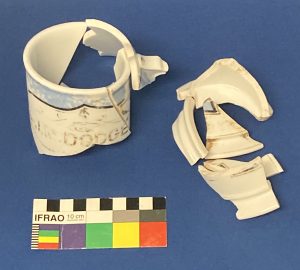
The Ampudia site was an urban residence located in Old Town, San Diego around the mid-1890s to the mid-1930s. It was owned and occupied by Mr. Andrew DeSota, his wife, and their six children. Based on historical documentation, Mr. DeSota had a shoeshine business of some type at a different location than his home residence. Mrs. DeSota worked at a separate business, as what was referred to as a “steam lady.”
There was only one porcelain item found in the DeSota assemblage besides the two shaving mugs that will be discussed in the next paragraph. Mr. DeSota does appear to have owned his own home and business, so this would suggest the family was able to at least make financial ends meet. The lack of porcelain tableware in an eight-member urban family may simply reflect other consumption priorities. Setting an attractive table, for status appearances only, may not have held as great an importance for this household as for some others.
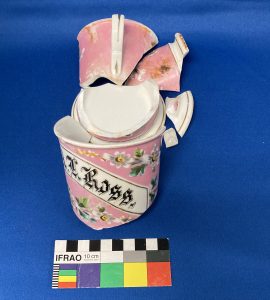
One of the most interesting aspects of the DeSota assemblage is the two personalized shaving mugs contained in it. These mugs, which are French porcelain, are decorated with what is likely the original owner’s name hand-painted in bold letters. During this period, barbershop customers preferred to have their own shaving mugs rather than sharing for sanitary reasons. Therefore, barbershops would store the personalized shaving mugs of their regular customers on shelves in the shop itself, ready for when the customer visited the barbershop. It is interesting that these mugs were individualized not with Mr. DeSota’s name, but with two other men’s names. Mr. DeSota did own a shoeshine business, and such businesses were often located in barbershops so customers could get a shave and shoe shine in one visit, but how would two personalized shaving mugs belonging to two other men end up in the DeSota residential assemblage? Did Mr. DeSota simply bring refuse from his work location to dispose of at his home, and why would he dispose of refuse from another business? Or did Mr. DeSota utilize the mugs for his own use? Or is there yet another explanation? It is impossible to know for sure, but it does offer a small glimpse into everyday life in turn-of-the-century San Diego.
La Entrada Apartments Project, Mitigation Monitoring – Jones Barrio Logan Community
Archaeological Excavation Site: City of San Diego
Site comprised of one well-constructed brick cistern and seven historic subsurface deposits
Time Span: Early 20th Century
Excavated by: Jones and Stokes in 2008
Curation: San Diego Archaeological Center, Collection Number SDAC 498
There is another urban homesite that was located in the Barrio Logan area of San Diego on Logan Ave. Although there is not much background documentation available for this site, there is an abundance of ceramic information. This assemblage includes multiple porcelain items, many of which are teacups and saucers, some with gold decoration. There are two German-made porcelain items in the Barrio Logan assemblage as well. These items may have been inherited family heirlooms or may even represent this family’s immigration from Germany. There were many German immigrants in turn-of-the-century San Diego. However, if this German porcelain was imported and purchased, it would have been an expensive choice.
In examining the few discernible maker’s marks on the Barrio Logan ceramic artifacts, it can be determined that those ceramic items were largely manufactured between 1900 and 1920, which would fit with the dating of this site as early 20th century. Also, according to information from the San Diego Historical Society, the Barrio Logan area began to rapidly grow sometime after 1905, which would likely also place the development of the site as early 20th century. Additionally, the households in the Barrio Logan area at that time spanned the economic spectrum including a few from among San Diego’s most prominent families. Without further historical documentation, it is not even possible to speculate about what the large inventory of ceramic items, including a high percentage of porcelain tableware, could have meant to this particular household. It would seem that such an impressive ceramic inventory would only have been financially accessible to a middle- or upper-class household. If the Barrio Logan family was of a higher economic status and/or possible social prominence, the family may have enjoyed or felt a responsibility to frequently entertain community members with elegant tea and dinner parties. If this was the case, porcelain tableware would have had particular meaning for this household and would have been a consumption priority.
The Cedar Street High Rise Project – Feature C – George Harris Household
Archaeological Excavation Site: Downtown San Diego
Site was associated with the address of the original Good Samaritan Hospital and a later multiple family dwelling
Time Span: 1890-1920
Excavated by: Affinis in 2005
Curation: San Diego Archaeological Center, Collection Number SDAC 418
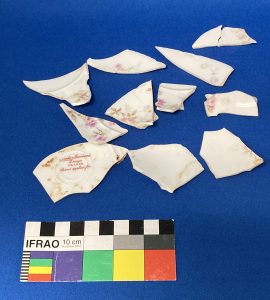
The last focus of this analysis will offer a contrast to the single household sites previously discussed. This site represents multiple family households, comparable to urban boarding house assemblages of the period. The site started out as the Good Samaritan Hospital and Home and was later purchased in about 1908 and turned into furnished rooms (likely rental) for several family households. By 1909, the building was rented to George Harris, a seventy-one-year-old house carpenter, and his fifty-six-year-old wife, Ella. They resided in part of the old two- story building and rented out the remainder of the building as furnished rooms. Some of the other boarders included a thirty-nine-year-old restaurant cook, his wife, and their nine year old daughter; and a thirty-seven-year-old automobile machinist. George Harris died in 1911, and by that time, the building was being used as apartments. Among the occupants were a thirty-year-old sales lady, a seventy-five-year-old designing engineer, and a real estate agent and his forty-four-year-old wife. By 1918, the apartments had come to be rented by a fairly mobile and transient population, a pattern that likely continued throughout the 1920s.
Within the Cedar St. site, there are three feature assemblages, each with distinctive ceramic consumption patterns. The assemblage referred to as Feature C is the largest of the three and ranges in deposition dates between 1905 and 1910. This is the feature assemblage selected for further analysis here. The ceramic contents of the Feature C assemblage form a pattern which closely resembles that of other urban boarding houses of the time period and location. It therefore makes sense to identify this particular assemblage as the refuse of the multiple rental boarders and the apartment occupants.
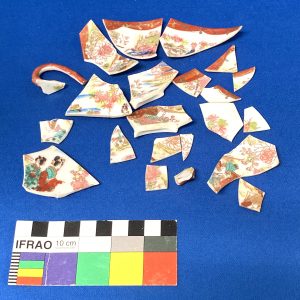
Two measures, based upon earlier archaeological research, can be used to analysis the Feature C assemblage’s similarity to other boarding house deposits. First, the percentage of kitchen items (cookware, serving ware, and tableware) and consumer items (containers such as bottles and tin cans) were almost evenly divided at around thirty-three percent, according to Van Wormer, Walter, and Robbins-Wade (Regardless Of Nationality Or Creed Or Is There A Room To Rent? 2007, pp. 97). This is very comparable to other urban boarding house sites. Also, the number of medicine bottles in this feature assemblage was extremely high, also comparable to other boarding house sites.
Another very interesting aspect of the Feature C ceramic assemblage is its cumulative monetary value, as measured by an updated version of the George Miller economic value scaling system (as discussed above). This updated relative index value system as utilized in Henry (Factors Influencing Consumer Behavior in Turn-of-the-Century Phoenix, Arizona 1987, pp. 359-381) determined the Feature C assemblage to be at a very high value level. In fact, “The high economic index value for Feature C is the highest for both single-family residence urban middle class sites or multiple-family working class dwelling collections” (Van Wormer, Walter, and Robbins-Wade 2007, pp. 97). Considering that George Harris and his wife were essentially running a boarding house, it would follow that the ceramic kitchenware items in the assemblage would have derived from them (unlike the consumer items that would likely have been purchased by the individual boarders). The very high value tableware artifacts, comprised of many porcelain and decorated items, would then reflect the consumer choices of the Harris family and would have been utilized by them. The large inventory of expensive tableware items may have become available to George Harris and his wife because of additional income resulting from renting furnished rooms, but why invest this additional income in expensive tableware? Is it possible that the Harris family was pursuing the dream of middle-class social status and thought the display of expensive tableware could project such newfound status? In that case, the tableware items may have had a very significant meaning for this family.
Conclusion
My path in examining the five ceramic assemblages above is a little different than others might have taken. I have tried to attach personal agency to the decision-making process of the individuals and households involved. Their ceramic consumption choices may well have been based on the meanings these items had for them, rather than on the household’s available wealth or supposed socioeconomic status. For many, a display of expensive and attractive tableware (especially in large quantities) may have been a way to show the quality items that they could afford to buy and therefore demonstrate that they were members of an elite social group. The absence of such expensive goods might indicate that they have some wealth but do not choose to display it in a manner that is contradictory to their value system or that they have other financial priorities besides expensive tableware. We cannot hope to understand the decisions and motivations of the people behind these assemblages without understanding that they were not so very different from us.
References
City of San Diego and Brian F. Smith and Associates, 2011, Barrio Logan Historical Resources Survey.
Cook, L., Yamin, R., and Mccarthy, J., 1996, Shopping as Meaningful Action: Toward a Redefinition of Consumption in Historical Archaeology. Historical Archaeology 30 (4): 50-65.
Dapper-Coonrod, Claire P., and Steven R. Kuehn, 2017, A Boarder, a Widow, and a Tenant Sit Down for Dinner: Foodway Comparisons in the Goose Hill Neighborhood, East St. Louis, Illinois, Midcontinental Journal of Archaeology, 42:1, 4-36.
Florida Museum, University of Florida, website last updated 1/25/2019, Introduction to Ceramic Identification, site visited several times in 2022, https://www.floridamuseum.ufl.edu/histarch/ceramic-types/introduction/.
Frye & Smith Official San Diego 1931 City Directory.
Garrow, P., 1987, The Use of Converging Lines of Evidence for Determining Socioeconomic Status, in Consumer Choice in Historical Archaeology, (Spencer-Wood S., editor), Plenum Press, New York, 217-231.
Henry, S., 1987, Factors Influencing Consumer Behavior in Turn-of-the-Century Phoenix, Arizona, in Consumer Choice in Historical Archaeology, (Spencer-Wood S., editor), Plenum Press, New York, pp. 359-381.
Henry, S., 1991, Consumers, Commodities, and Choices: A General Model of Consumer Behavior. Historical Archaeology 25 (2): 3-14.
Kovel, R., and Kovel, T., 1986, New Dictionary of Marks: Pottery and Porcelain, 1850 to the Present, Crown Publishers, New York.
Majewski, T., and O’Brien M., 1987, The Use and Misuse of Nineteenth Century English and American Ceramics in Archaeological Analysis, in Advances in Archaeological Method and Theory, (Schiffer M., editor), Springer, New York, pp. 97-209.
Miller, G., 1980, Classification and Economic Scaling of 19th-Century Ceramics. Historical Archaeology 14:1-40.
Miller, G., 1991, A Revised Set of CC Index Values for Classification and Economic Scaling of English Ceramics from 1787 to 1880. Historical Archaeology 25:1-25.
San Diego Historical Society Quarterly of Winter 1983.
Spencer-Wood, S., 1987, Miller’s Indices and Consumer-Choice Profiles Status-Related Behaviors and White Ceramics, in Consumer Choice in Historical Archaeology, (Spencer-Wood S., editor), Plenum Press, New York, pp.321-358.
VanderVeen, J., 2007, People, Pots, and Prosperity: The Ceramic Value Index and an Assumption of Economic Class in the Proceedings of the Indiana Academy of Science, Dec. 31, 2007.
Worthy, L., 1982, Classification and Interpretation of Late Nineteenth And Early Twentieth-Century Ceramics in Archaeology of Urban America: The Search for Pattern and Process, (Dickens, R., editor), Academic Press, New York, pp. 329-360.
SDAC Assemblages References
Cultural Resources Mitigation Monitoring Report, 2016, La Entrada Apartments Project, Barrio Logan Community, City of San Diego and historic ceramic assemblage, housed at the San Diego Archaeological Center, Collection Number SDAC 498.
Smith, B., and Associates, 2011, Old Town San Diego Historic Refuse Deposit, The Ampudia Lot Project, DeSota Homesite historic ceramic assemblage, housed at the San Diego Archaeological Center, Collection Number SDAC 546.
Van Wormer, S., and Wade, S., 2000, Historic And Archaeological Analysis, The Village At Euclid Property, 1925-1932 Rice Homesite historic ceramic assemblage, housed at the San Diego Archaeological Center, Collection Number SDAC 47.
Van Wormer, S., and Walter, S., 2001, Every Bit of Rubbish, Archaeological Data Recovery For The Liffreing House Dump, and Liffreing House historic ceramic assemblage, housed at the San Diego Archaeological Center, Collection Number SDAC 122.
Van Wormer, S., Walter, S., and Robbins-Wade, M., 2007, Regardless Of Nationality Or Creed Or Is There A Room To Rent? Historical and Archaeological Investigations at the Site of the Good Samaritan Hospital and an Urban Multiple Family Dwelling, Middle Town Addition Block 23, Cedar Street High Rise Project, Feature C historic Ceramic assemblage, housed at the San Diego Archaeological Center, Collection Number SDAC 418.


